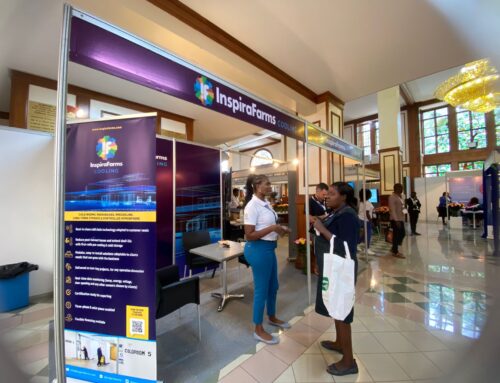July Webinar – Pre-cooling & cold chain is a must, but what’s the ROI?
Date: Thursday 29th of July 2021, 4.00-5.00pm CET, 5.00-6.00pm EAT
Channel: Zoom webinar
REGISTER HERE: https://us02web.zoom.us/webinar/register/WN_PuXLUD7PSqGB1US2qJVTdg
Approach: Sharing positive results on RoI when adopting appropriate and novel postharvest technologies, especially around precooling.
Speakers:
- Julian Mitchell – CEO, InspiraFarms
- Marco Borghesi – Head of Product, InspiraFarms
- Yassine Benider – Ifria/Lixcap
- Glen Roelofsz – Claremont Farm, Ariston Group Zimbabwe
- Michele Bruni, CCO, InspiraFarms – Moderator
Topic background
Most agribusinesses in fruit and vegetable supply chains are thinking of investing in cold chain technology for increasing productivity, efficiency, and revenue by entering high-value markets, such as export. However, considering the investment required and the uncertainty around future returns, it is very common for businesses to be reluctant to invest and make the right choice around technology.
In order to invest in even the most adequate and cost-effective cold chain elements, the farmer, aggregator, or trader must be confident that the operation and market will reward the investment. There are many technical and investment challenges, but with great economic opportunities related to the use of the cold chain that agribusinesses need to understand.
This webinar has the objective of responding to these questions:
- What’s the ROI and lifetime value of on-farm pre-cooling and first-mile cold-chain? What are the factors that increase savings and profitability?
- What does energy efficiency and real-time remote monitoring for cold chain management, what are their benefits and direct contribution to ROI mean?
As an example, the ROI of InspiraFarms on-farm precooling and cold chain technology, based on customer results on high-value crops export (berries) a comparison with alternative traditional solutions reported:
- IRR at 5 years 150%
- 5% of rejections (50% of traditional solution)
- €600,000 additional cumulative revenues compared to traditional solution
- Losses cut by 49%
- Margin per kg sold increased by 17%
- 18% reduced cost
- 25% reduced total OPEX per kg sold
The main drivers that provide ROI and lifetime value to cold chain technology are:
Increased value from produce
The integration of on-farm pre-cooling and cold-chain has direct positive impacts on the value and return from fresh produce. Pre-cooling retains shelf-life, quality and reduces losses and potential rejections, generating more value which is anticipated to cover the cost of accessing the cold room, leaving farmers and agribusinesses with a net income higher than without the cold room.
Energy-efficiency savings
Energy efficiency of any cold chain technology will affect both feasibility and economic sustainability. The worst cold room consumed over 8 times as much energy per storage unit when compared to the most efficient cooling facility. The most tangible way to see the results of energy efficiency is by facilitating a drastic reduction in the amount of energy used which thus translates into reduced energy bills. Energy-efficient systems can contribute with more than 30% reduced annual energy cost dedicated to cooling, compared with other technologies.
Savings through energy-efficient cooling is reached with the combination of different efficient technology components. For example, new generation compressors use less energy to supply a given pressure, with savings of more than 4-10%. Electronically commutated evaporator/condenser -fan motors allow energy savings of around 19%. Variable speed drive (VSD) fitted to the compressor saves 9-19% energy compared to a fixed speed. And, rigid polyurethane foam allows thermal insulation for higher retention of desired temperatures, with energy savings of around 6%.
Savings & returns of remote monitoring
Remote monitoring enables more granular and consistent measurement and capture of data on different indicators such as fruit and vegetable cooling and storage conditions, energy consumption, and machinery performance. It also allows the supervision of quality compliance protocols, cooling performance (temperature and humidity levels), and cold room conditions such as energy consumption, CO2 levels, and even employees’ and facility’s safety control.
It minimizes the waste of fresh produce by preventing product loss by managing cooling temperatures and controlling crop quality and with an instant share of detailed quality reports with buyers that potentially reduces claims and rejections. As well it enables early diagnosis of issues, reducing considerably potential downtime.
All these operational controls and supervisions are traditionally done manually, requiring more than 3 hours of work daily. Through remote monitoring, this manpower can be refocused on other tasks, and labor productivity can be increased. Complete digital monitoring of pre-cooling and cold chain operations can contribute to more than 10% of total operational cost savings, with a direct contribution in increasing crops value and returns.
Driving questions :
- How important is it to get the postharvest right? What is the key expected impact on the agribusinesses and supply chains’ bottom line?
- What does a positive ROI and lifetime value of pre-cooling and cold chain in fruit and vegetable supply chains mean? What are the examples?
- How should the lifetime value of pre-cooling and cold chain be calculated and analyzed?
- What does energy efficiency in pre-cooling and cold chain of fresh fruit and vegetables mean? What technical components generate energy efficiency in cooling operations?
- What does remote monitoring and IoT data gathering for pre-cooling and cold chain mean? How does this contribute to operational efficiency?
- What real examples of efficient pre-cooling and cold chain technologies applied to on-farm post-harvest management are bringing positive results on ROI and lifetime value?



